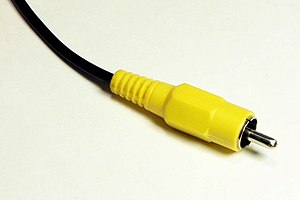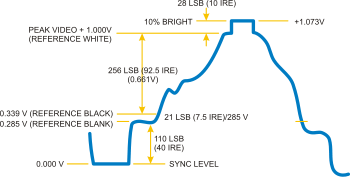Usuário:Spra/Proj03


Composite video is the format of an analog television (picture only) signal before it is combined with a sound signal and modulated onto an RF carrier.
Vídeo composto Composite video is often designated by the CVBS acronym, meaning any of "Color, Video, Blank and Sync", "Composite Video Baseband Signal", "Composite Video Burst Signal", or "Composite Video with Burst and Sync".
It is usually in a standard format such as NTSC, PAL, or SECAM. It is a composite of three source signals called Y, U and V (together referred to as YUV) with sync pulses. Y represents the brightness or luminance of the picture and includes synchronizing pulses, so that by itself it could be displayed as a monochrome picture. U and V between them carry the color information. They are first mixed with two orthogonal phases of a color carrier signal to form a signal called the chrominance. Y and UV are then combined. Since Y is a baseband signal and UV has been mixed with a carrier, this addition is equivalent to frequency-division multiplexing.
Composite video can easily be directed to any broadcast channel simply by modulating the proper RF carrier frequency with it. Most analog home video equipment records a signal in (roughly) composite format: LaserDiscs store a true composite signal, while VHS tapes use a slightly modified composite signal. These devices then give the user the option of outputting the raw signal, or modulating it on to a VHF or UHF frequency to appear on a selected TV channel. In typical home applications, the composite video signal is typically connected using an RCA jack, normally yellow (often accompanied with red and white for right and left audio channels respectively). BNC connectors and higher quality co-axial cable are often used in more professional applications.
In Europe, SCART connections are often used instead of RCA jacks (and to a lesser extent, S-Video), so where available, RGB is used instead of composite video with computers, video game consoles, and DVD players.
Some devices that connect to a TV, such as VCRs, older video game consoles and home computers of the 1980s, naturally output a composite signal. This may then be converted to RF with an external box known as an RF modulator that generates the proper carrier (often for channel 3 or 4 in North America, channel 36 in Europe). The RF modulator is preferably left outside the console so the RF doesn't interfere with the components inside the machine. VCRs and similar devices already have to deal with RF signals in their tuners, so the modulator is located inside the box. Also, most early home computers usually employed an internal RF modulator.
The process of modulating RF with the original video signal, and then demodulating the original signal again in the TV, introduces several losses. RF is also "noisy" because of all of the video and radio signals already being broadcast, so this conversion also typically adds noise or interference to the signal as well. For these reasons, it is typically best to use composite connections instead of RF connections if possible. Almost all modern video equipment has at least composite connectors, so this typically isn't a problem; however, older video equipment and some very low-end modern televisions have only RF input (essentially the antenna jack); while RF modulators are no longer common, they are still widely available to translate baseband signals for older equipment.
However, just as the modulation and demodulation of RF loses quality, the mixing of the various signals into the original composite signal does the same, causing a checkerboard video artifact known as dot crawl. Dot crawl is an infamous defect that results from crosstalk due to the intermodulation of the chrominance and luminance components of the signal. This is usually seen when chrominance is transmitted with a high bandwidth, and its spectrum reaches into the band of the luminance frequencies. This has led to a proliferation of systems such as S-Video and component video to separate out one or more of the mixed signals.
When used for connecting a video source to a video display where both support 4:3 and 16:9 display formats, the PAL television standard provides for signalling pulses that will automatically switch the display from one format to the other. The Composite video connection supports this operation. However the NTSC television standard has no such provision, and thus the display will have to be manually switched.
Extensions to the composite video standard
editarSince many TV screens have cropped part of the output of a composite video signal, extensions have been implemented by taking advantage of this unseen plane of output, and examples of these extensions include closed captioning, digital information regarding the show title, etc.
Other extensions to the standard include S-video; S-video is an extension to the standard because it uses 2 parallel signals, one for luminance and one for chrominance (color).
See also
editarExternal links
editar- Maxim - Apr 17, 2001 - Video Basics Tutorial covering CVBS format structure.